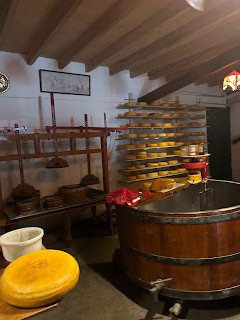The Switch from Urban to Rural Infrastructure
Going from the urban environment to a completely rural area in and outside of Amsterdam takes about 20 minutes, and there is generally no suburbia you go through to get there. As you move through, the infrastructure changes as well because there is less traffic on the roads.
Most of the rural infrastructure includes one shared lane for car traffic going both ways in the middle and two painted bike lanes on either side. There are also speed bumps and curbs to narrow the streets every so often. After riding on this for a while, it was clear that it worked because there was rarely two cars passing each other going different directions, and the traffic calming kept the cars going at such a low speed that if another car was passing in the opposite direction, there was enough time to figure out who would slow down to let the other car pass.
Why This Might Not Work in the US
Despite this infrastructure working well for the rural area here, I don't think this would necessarily be a wise idea for the US.
The Netherlands has a developed bike culture and most people in cars also ride bikes, so they treat cyclists like human beings and don't come close to killing them over road rage every day. This allows for the shared car lane and the unprotected cycle lanes to work in this instance. In the US, however, we do not have this developed culture, and while this might work in truly rural areas, I don't think it would be best for the more suburban areas where it issometimes proposed. The one way that this might work is with serious traffic calming measures, like narrowing the lanes and curbs, but it could be dangerous to do with the car dominant culture in America and most cyclists would appreciate more protection.
Rural Activities and Bike Access
Swimming
Outside of Amsterdam, there is a lake where we went to swim, which was cool to see within the rural part of the country that wasn't near the coast and it included a restaurant and grassy areas to give the people living there something fun to do on a summer day.
The best thing about it was that the bike access was clearly prioritized, and we didn't even realize there was car access at all because the car parking was so out of the way. The cycle tracks were directly connected to the lake and there were large bike parking facilities right as you entered, which were both completely separated from the car parking facilities and the roads. It was pretty cool to see biking being prioritized at a swimming spot, because I've never seen that before at any beaches or lakes I've been to in the US, and it seems intuitive to want to bike back and dry off in the fresh air after going swimming.
Cheese and Clog Shop
We went to a farm where cheese and clogs are made, and although it was a weird experience, it was cool to see how they prepare cheese and make clogs in the rural Netherlands. There was also a lot of farmland nearby, with bike infrastructure flowing through it, which was nice to bike through. The journey to the clog shop was very bike friendly and we were able to bike side-by-side for most of the way. The driveway to the clog shop was also very narrow and clearly meant for bikes to be arriving.
Overall, the rural experience was very cool and it is super interesting that we were able to make it to all of these locations in under an hour on our bikes.









No comments:
Post a Comment